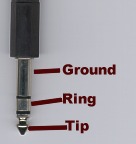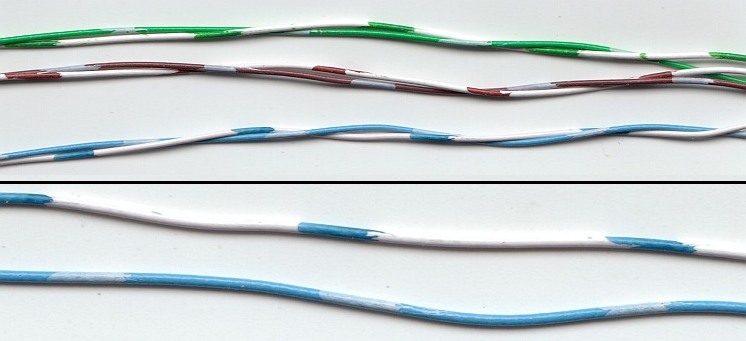 The common ¼ inch stereo phone plug. It was originally designed by the Bell Telephone Company around 1880, for use on telephone switch boards. That is why it is called a phone plug. The name has nothing to do with a phonograph. When used with stereo headphones, the tip is used for the left channel and the ring is the right channel. The ground is a common return path for both the left and right channel conductors. It's call the Ring because it looks like a ring around the center of the plug. The Tip is on the "tip" of the plug.
The common ¼ inch stereo phone plug. It was originally designed by the Bell Telephone Company around 1880, for use on telephone switch boards. That is why it is called a phone plug. The name has nothing to do with a phonograph. When used with stereo headphones, the tip is used for the left channel and the ring is the right channel. The ground is a common return path for both the left and right channel conductors. It's call the Ring because it looks like a ring around the center of the plug. The Tip is on the "tip" of the plug.
It takes 2 wires to make a circuit, therefore phone lines are discussed in pairs. The label "tip" is usually the positive conductor and the "ring" is usually the negative conductor. They would connect to the phone switch board plugs as shown in the photo above.
There are two standard color codes used with phone wires. The oldest is slowly being abandoned in larger cables of more than 6 or 8 conductors, because the new one is much easier to learn and is more flexible. The old color code consisted of a very complicated combination of solid colors. Here are the colors for small cables.
| tip | ring | |
| first pair | green | red |
| second pair | black | yellow |
| third pair | white | blue |
And so on, going up to 25 pair and becoming very difficult to remember. In fact the code is so old now that I can't remember it beyond white-blue and can't find it in any of my catalogues.
"I used to have a telephone manuel from the late 30's-early 40's that had the standard (current) Color code. The determining factor for using the colors that they did, had to do with the ease of identification along with the availability of dyes for cloth cordage. ie they wanted cheap easy to use dyes that were easy to identify."
|
The group colors are White Red Black Yellow Violet |
The pair colors are Blue Orange Green Brown Slate |
Most cables that are not phone company trunk or feeder lines are marked using 2 colors on each wire. If you look closely at the bottom 2 wires, pictured below, you will notice that one wire is mostly white with a regular band of blue. This is the Tip. The second wire is mostly blue with an regular band of white. This is the ring. The wires are twisted to prevent the signal on one pair of wires from "leaking" into the others. When this happens it is called "cross talk" and can be caused by a number of different conditions.

In each pair, the wire with the most color that matches a group color is the tip and the wire with the most color that matches a pair color is the ring.
| First group... | tip | ring |
| first pair | white-blue | blue-white |
| second pair | white-orange | orange-white |
| third pair | white-green | green-white |
| forth pair | white-brown | brown-white |
| fifth pair | white-slate | slate-white |
This makes 1 group, or 10 wires, or 5 pair, or 5 phone lines.
The second group color is red. Thus...
| Second group... | tip | ring |
| first pair | red-blue | blue-red |
| second pair | red-orange | orange-red |
| third pair | red-green | green-red |
| fourth pair | red-brown | brown-red |
| fifth pair | red-slate | slate-red |
Using this system you can bundle 50 wires, or 25 pair together with no two wires having the same color combination.
In cables with more than 25 pair, the first group of 50 wires are wrapped with 2 narrow plastic ribbons, one white one blue. The next 50 wires are wrapped with ribbons of white and orange. Under most conditions, this is as many as it goes, interior cables are seldom larger than 50 pair. For some reason, which I have never been able to discover, the next 2 bundles use red and blue and red and orange, however it is very rare to find cables this large except in big buildings wired in the early 1960s.
In most newer homes and apartments you will find cables using this newer color code. Normally they only use up to the white-green or maybe to the white-brown pair, giving you 3 or 4 pair. Occasionally homes wired in the 70s had bundles using up to the red-blue pair giving capability of up to 6 phone lines. Sometimes these bundles of wires may be covered with an outer jacket or sheath which may be gray, brown or white.
Update: August 8, 2012: I recently found out that the reason for pulling 6 pair cables (12 wires) was in hopes of selling a system that was called The "Home and Farm Interphone" which required 12 wires between sets. This was an attempt by Ma Bell to produce an intercom system for home use using phone sets and small axillary speakers around the house. It was quite expensive so it had a limited sales market and I have been told by one phone collector that it didn't work very well.
Commonly, houses that were pre-wired with this type of cable, would have the cable pulled in a loop. This simply means the installer pulled the cable out of the center of the box, folded it over, and pulled 2 cables through the walls. When you find this kind of installation, it has the appearance of twice as many wires. Another result is the look of a rats nest when you remove an outlet plate. The reasoning behind this practice was to allow for the possibility of a broken wire in the wall. If a break occurred somewhere in the wall, the home owner wouldn't notice any thing wrong because the signal would go around through the far end of the cable and come back to the phone from the other end.
As a matter if interest, most modern computer networks listed as 10-base-T, 100-base-T or even 1,000-base-T (Giga-bit) use the same color codes, although they use different combinations of the conductors than the phone lines.